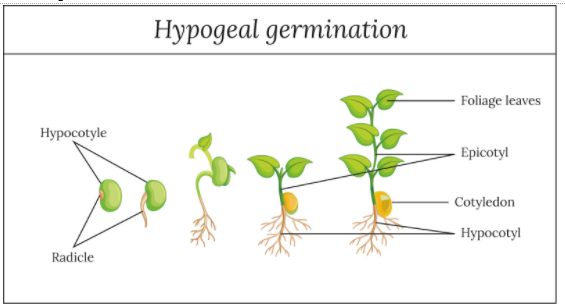
Germination is hypogeal in -
(a)Cotton
(b)Pea
(c)Castor
(d)Bean
Answer
480k+ views
Hint: The term ‘hypo’ means below something. And since we are understanding about germination, there are plants that may germinate above or below the ground surface. Germination can occur above or below ground depending on the type of the plant seed.
Complete answer:
- Hypogeal germination is the type where the cotyledons stay below the ground, the epicotyl above the cotyledon grows, while the hypocotyl below the cotyledon remains the same in length.
- Examples of hypogeal germination include pea, mango, maize, and lily.
- Here, the plumule pushes the cotyledons out of the soil.
- The cotyledons are fleshy and as they stay below ground, they develop a survival strategy that they are resistant to cold temperatures or grazing.
Additional Information: - In the case of epigeal germination, the cotyledons are above the soil surface as the hypocotyl elongates very rapidly. The epicotyl remains unchanged in length.
- The options cotton, castor, and bean (or common bean) are examples of epigeal germination.
- Hypogeal germination also occurs in plants where low nutrient soils and low sunlight conditions are favored. They are also resistant to flooding.
- As epigeal germination plants are more vulnerable to grazing and weather conditions, the plants produce a large number of seeds as an evolutionary strategy.
- Plants with hypogeal germination grow relatively slower while those with epigeal germination grow faster. This is also dependent on their resistance to flooding. Since epigeal plants are not resistant to flooding, rapid growth allows them to develop before the area is flooded again.

So, the correct answer is ‘Pea’.
Note: - Two species in the same genus can show different types of germination. For example, the runner bean or the Phaseolus coccineus shows hypogeal germination while the common bean Phaseolus vulgaris shows epigeal germination.
Complete answer:
- Hypogeal germination is the type where the cotyledons stay below the ground, the epicotyl above the cotyledon grows, while the hypocotyl below the cotyledon remains the same in length.
- Examples of hypogeal germination include pea, mango, maize, and lily.
- Here, the plumule pushes the cotyledons out of the soil.
- The cotyledons are fleshy and as they stay below ground, they develop a survival strategy that they are resistant to cold temperatures or grazing.
Additional Information: - In the case of epigeal germination, the cotyledons are above the soil surface as the hypocotyl elongates very rapidly. The epicotyl remains unchanged in length.
- The options cotton, castor, and bean (or common bean) are examples of epigeal germination.
- Hypogeal germination also occurs in plants where low nutrient soils and low sunlight conditions are favored. They are also resistant to flooding.
- As epigeal germination plants are more vulnerable to grazing and weather conditions, the plants produce a large number of seeds as an evolutionary strategy.
- Plants with hypogeal germination grow relatively slower while those with epigeal germination grow faster. This is also dependent on their resistance to flooding. Since epigeal plants are not resistant to flooding, rapid growth allows them to develop before the area is flooded again.

So, the correct answer is ‘Pea’.
Note: - Two species in the same genus can show different types of germination. For example, the runner bean or the Phaseolus coccineus shows hypogeal germination while the common bean Phaseolus vulgaris shows epigeal germination.
Recently Updated Pages
The correct geometry and hybridization for XeF4 are class 11 chemistry CBSE

Water softening by Clarks process uses ACalcium bicarbonate class 11 chemistry CBSE

With reference to graphite and diamond which of the class 11 chemistry CBSE

A certain household has consumed 250 units of energy class 11 physics CBSE

The lightest metal known is A beryllium B lithium C class 11 chemistry CBSE

What is the formula mass of the iodine molecule class 11 chemistry CBSE

Trending doubts
State the laws of reflection of light

One Metric ton is equal to kg A 10000 B 1000 C 100 class 11 physics CBSE

Difference Between Prokaryotic Cells and Eukaryotic Cells

How do I convert ms to kmh Give an example class 11 physics CBSE

Describe the effects of the Second World War class 11 social science CBSE

Which of the following methods is suitable for preventing class 11 chemistry CBSE




